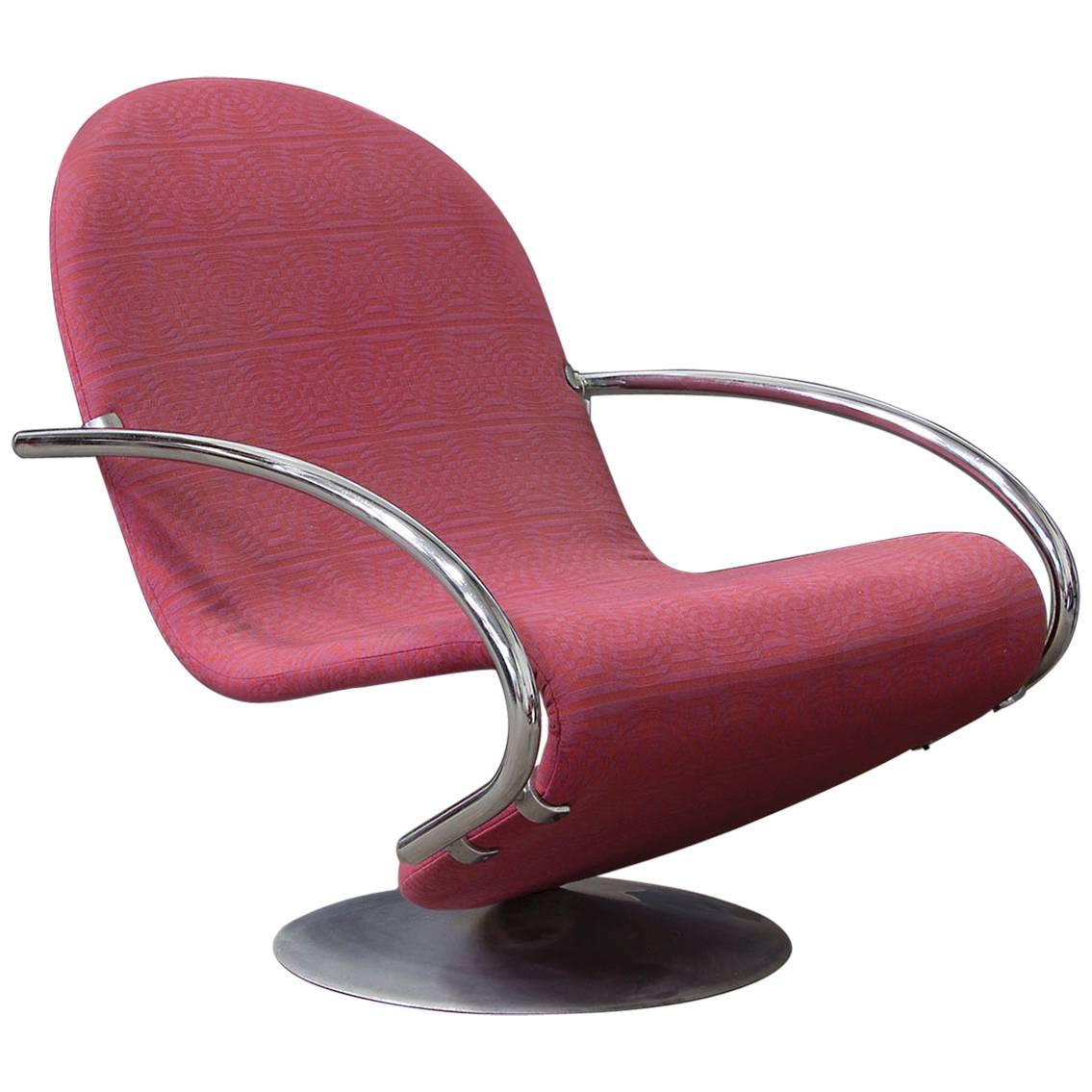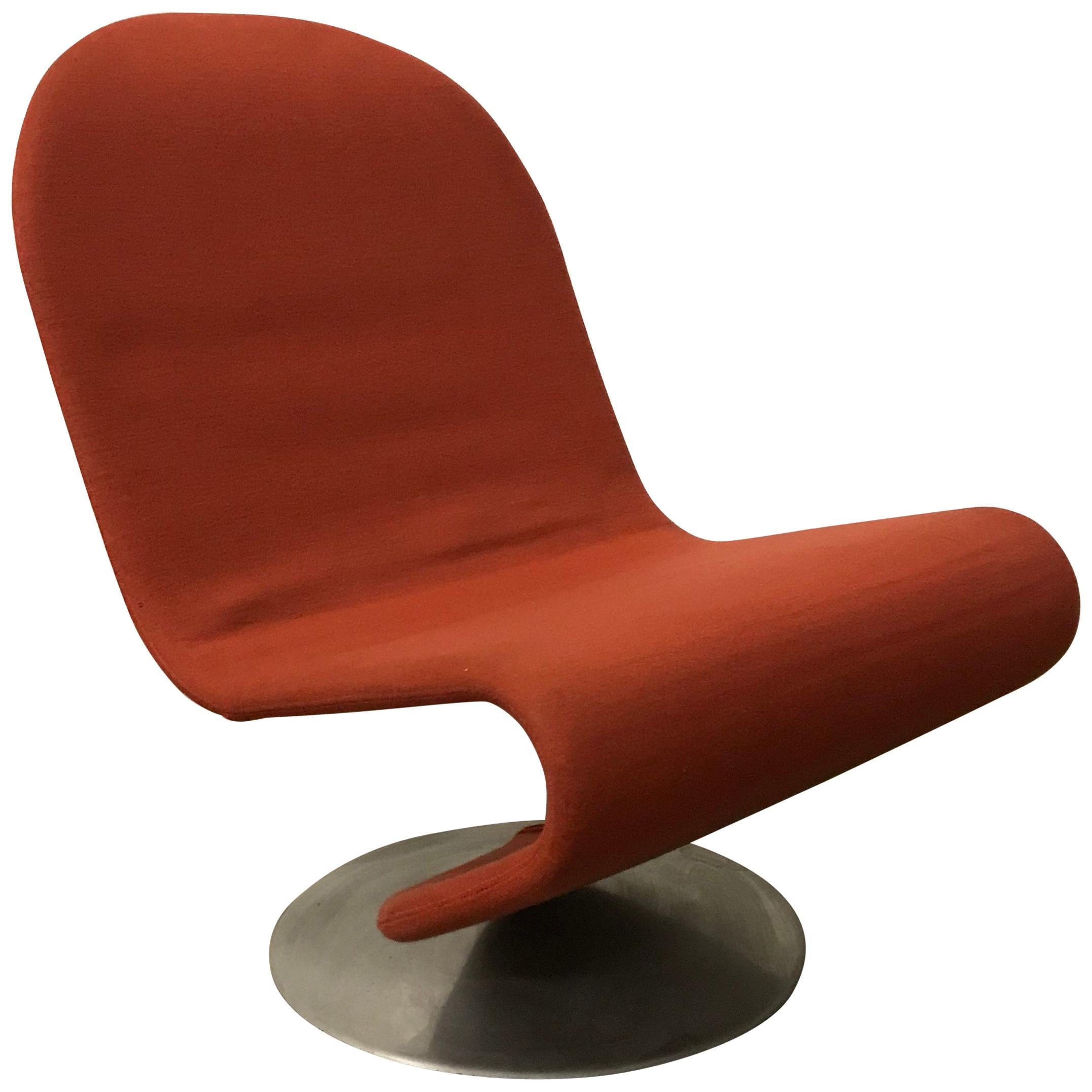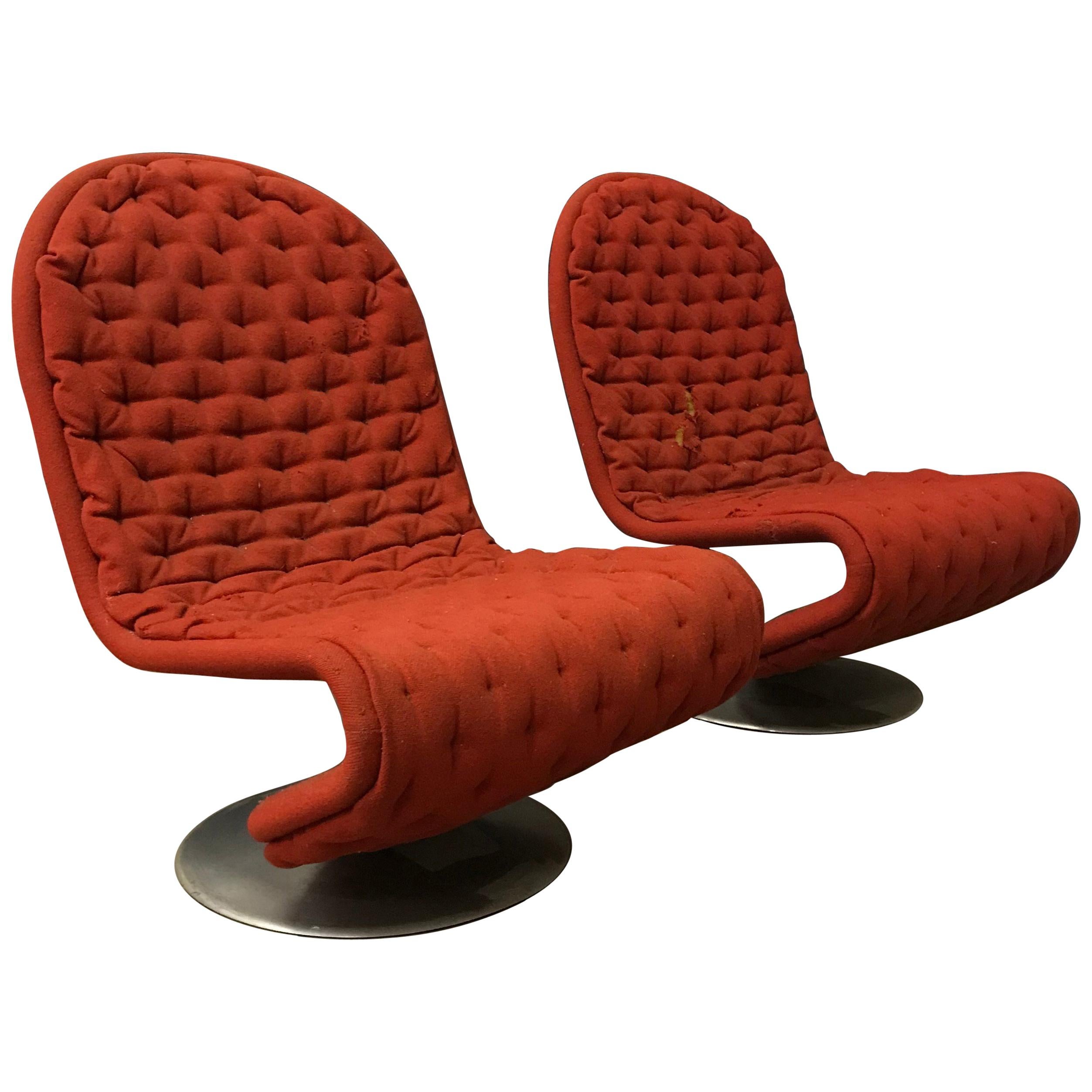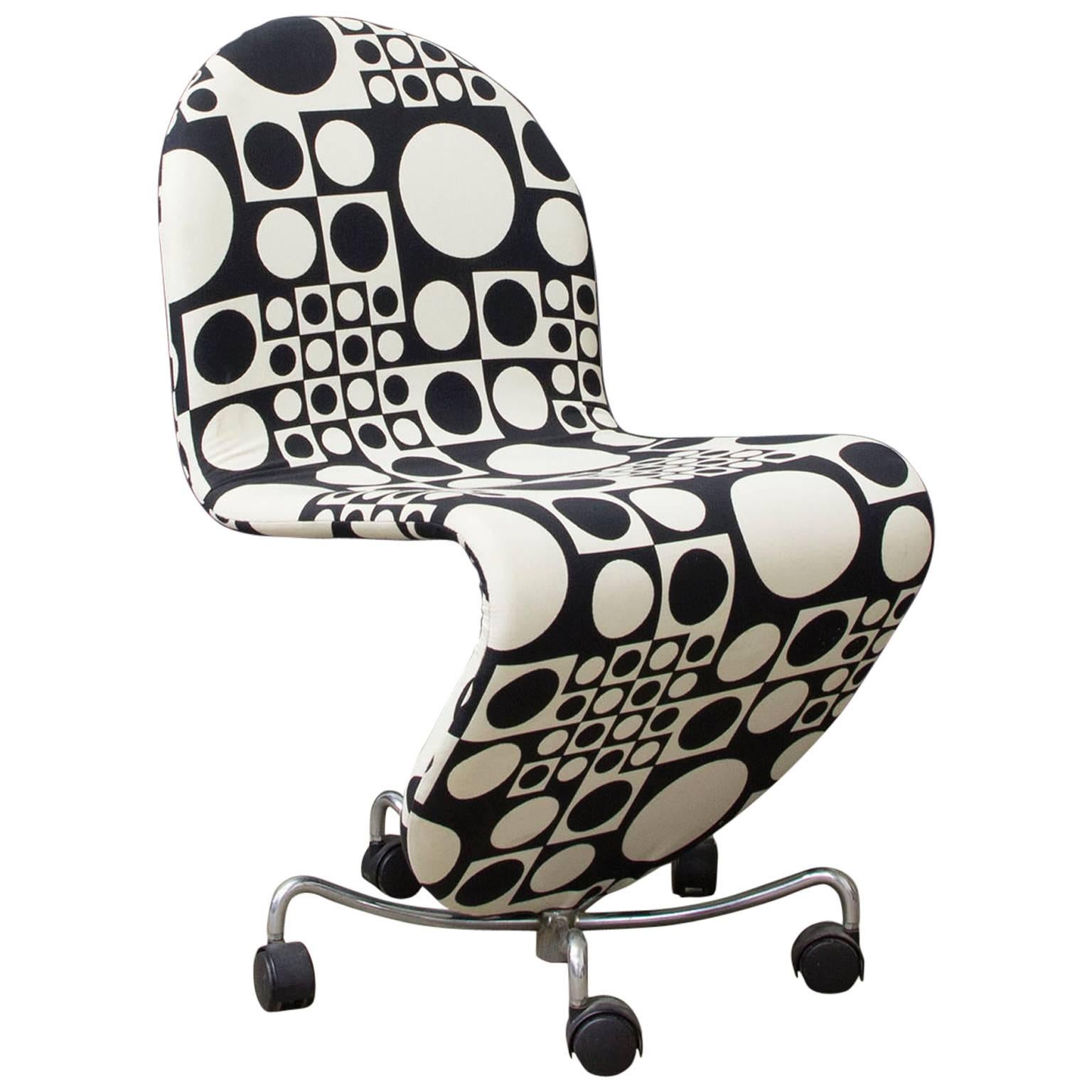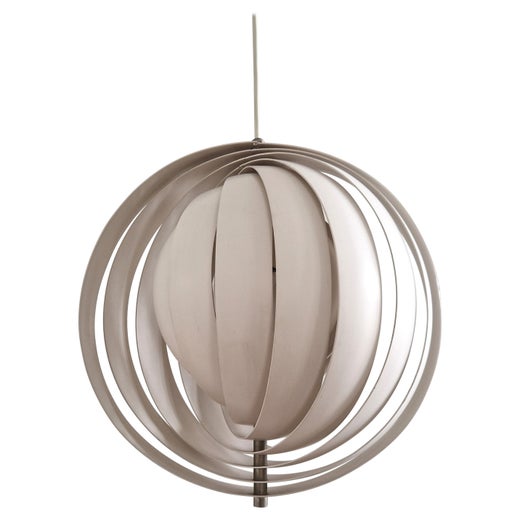1973, Verner Panton, 1-2-3 Serie Easy Chair in Original Panton Fabric
About the Item
- Creator:Rosenthal (Manufacturer),Verner Panton (Designer)
- Dimensions:Height: 31.5 in (80 cm)Width: 27.56 in (70 cm)Depth: 32.29 in (82 cm)Seat Height: 13.78 in (35 cm)
- Style:Mid-Century Modern (Of the Period)
- Materials and Techniques:
- Place of Origin:
- Period:
- Date of Manufacture:circa 1975
- Condition:Reupholstered. Wear consistent with age and use.
- Seller Location:Amsterdam IJMuiden, NL
- Reference Number:1stDibs: LU205536937523
Verner Panton
Verner Panton introduced the word “groovy” — or at least its Danish equivalent — into the Scandinavian modern design lexicon. He developed fantastical, futuristic forms and embraced bright colors and new materials such as plastic, fabric-covered polyurethane foam and steel-wire framing for the creation of his chairs, sofas, floor lamps and other furnishings. And Panton’s ebullient Pop art sensibility made him an international design star of the 1960s and ’70s. This radical departure from classic Danish modernism, however, actually stemmed from his training under the greats of that design style.
Born on the largely rural Danish island of Funen, Panton studied architecture and engineering at Copenhagen’s Royal Danish Academy of Fine Arts, where the lighting designer Poul Henningsen was one of his teachers. After graduating, in 1951, Panton worked in the architectural office of Arne Jacobsen, and he became a close friend of Hans Wegner's.
Henningsen taught a scientific approach to design; Jacobsen was forever researching new materials; and Wegner, the leader in modern furniture design using traditional woodworking and joinery, encouraged experimental form.
Panton opened his own design office in 1955, issuing tubular steel chairs with woven seating. His iconoclastic aesthetic was announced with his 1958 Cone chair, modified a year later as the Heart Cone chair. Made of upholstered sheet metal and with a conical base in place of legs, the design shocked visitors to a furniture trade show in Copenhagen.
Panton went on to successive bravura technical feats. His curving, stackable Panton chair, his most popular design, was the first chair to be made from a single piece of molded plastic.
Panton had been experimenting with ideas for chairs made of a single material since the late 1950s. He debuted his plastic seat for the public in the design magazine Mobilia in 1967 and then at the 1968 Cologne Furniture Fair. The designer’s S-Chair models 275 and 276, manufactured during the mid-1960s by August Sommer and distributed by the bentwood specialists at Gebrüder Thonet, were the first legless chairs crafted from a single piece of plywood.
Panton would spend the latter half of the 1960s and early ’70s developing all-encompassing room environments composed of sinuous and fluid-formed modular seating made of foam and metal wire. He also created a series of remarkable lighting designs, most notably his Fun chandeliers — introduced in 1964 and composed of scores of shimmering capiz-shell disks — and the Space Age VP Globe pendant light of 1969.
Panton’s designs are made to stand out and put an eye-catching exclamation point on even the most modern decor.
Find vintage Verner Panton chairs, magazine racks, rugs, table lamps and other furniture on 1stDibs.
Rosenthal
While the Rosenthal Porcelain Factory grew from humble decorating roots — as many pottery companies do — it eventually built a list of universally revered designer and artist partners that included Andy Warhol and Salvador Dalí. And after securing an enviable position as a top manufacturer of serveware and dominating the porcelain and bone china markets, Rosenthal expanded into furniture production, working with influential designers Verner Panton, Luigi Colani and Günther Ferdinand Ris and Herbert Selldorf.
German-born Jewish businessman Philipp Rosenthal founded the company in 1879 in Bavaria. It began as his modest workshop where he painted porcelain and encountered success with porcelain ashtrays. Rosenthal hired the best designers and clay modelers he could find. Adolf Oppel designed figurative Art Nouveau pieces, while Eleonore (Lore) Friedrich-Gronau produced decorative objects, namely her graceful porcelain dancer figurines, for the company.
Dinnerware, though, would be a Rosenthal mainstay. Between 1904 and 1910, Rosenthal produced its renowned dinnerware lines such as Donatello, Darmstadt and Isolde. These were introduced as unornamented white pieces — only later were they given their underglaze designs.
Rosenthal founder Philipp, a Catholic of Jewish ancestry, resigned in 1934 as the company’s president due to pressures owing to discriminatory German laws that took shape during the rise of the Nazi regime. Rosenthal died in 1937, and the family fled to America. The company would not regain its footing until 1950 when Rosenthal’s son, Philip, joined the firm and, in 1958, became chairman and dubbed Germany’s “China King.” At its peak, the company had 10,000 employees.
In the 1950s, Rosenthal’s modernist dinnerware was a significant part of the brand’s offerings, and by 1961 they introduced the famed Rosenthal Studio Line. Although furniture designers and ceramicists would lead the list of individuals working with Rosenthal — among them Tapio Wirkkala, Max Weber and Lisa Larson — the company eventually reached out to fine artists, not only Dalí and Warhol but Sandro Chia and Kenny Scharf. Rosenthal also collaborated with fashion designers Gianni Versace and Donatella Versace.
In a daring move in 1972, the company diversified into furniture, collaborating with some of the giants of mid-century modern design. The revolutionary Sunball chair, an icon of Space Age seating crafted by Selldorf and Ris, was among Rosenthal’s stellar successes in this venture.
On 1stDibs, find vintage Rosenthal ceramics, porcelain, tableware, seating and more.
- ShippingRetrieving quote...Ships From: IJmuiden, Netherlands
- Return PolicyA return for this item may be initiated within 7 days of delivery.
- 1973, Verner Panton, 1-2-3 Serie Easy Chair in Original Panton FabricBy Fritz Hansen, Verner PantonLocated in Amsterdam IJMuiden, NLThis item is part of the private collection of Casey Godrie and is situated in his private house. Ask him for competitive shipping quotes. His incredible Dune Villa, Amsterdam Beach,...Category
Vintage 1970s Danish Scandinavian Modern Lounge Chairs
MaterialsMetal
- 1973, Verner Panton, 1-2-3 Serie Easy Chair in Original First FabricBy Fritz Hansen, Verner PantonLocated in Amsterdam IJMuiden, NLThis item is part of the private collection of Casey Godrie and is situated in his private house. Ask him for competitive shipping quotes. His incredible Dune Villa, Amsterdam Beach, check last pictures on this listing and/or find more details on his family name plus eu, is for sale soon too. :-) 1-2-3 Pierre Paulin in terracotta. The upholstery is of a jersey stretch fabric in fair to good condition, with some tiny stains and a light moist stain on the left side of the seat. The foot has some traces of wear but is good. The chair is rotatable. The weight is 9.5 kg Free shipping for Amsterdam, Haarlem and IJmuiden for lamps, chairs, small items as tables and office desks, small not too heavy couches. Key designers for the tubular steel furniture, which became famous in the 1930s by companies as Thonet, Gispen, Auping, Fana Metaal, de Wit Schiedam...Category
Vintage 1970s Danish Mid-Century Modern Lounge Chairs
MaterialsMetal
- 1973 Verner Panton, 1-2-3 Serie Easy Chair in Original First FabricBy Fritz Hansen, Verner PantonLocated in Amsterdam IJMuiden, NLThis item is part of the private collection of Casey Godrie and is situated in his private house. Ask him for competitive shipping quotes. His incredible Dune Villa, Amsterdam Beach...Category
Vintage 1970s Danish Mid-Century Modern Lounge Chairs
MaterialsMetal
- 1970, Verner Panton, 1-2-3 Serie Office Chair, Original Panton Fabric by KvadratBy Rosenthal, Verner PantonLocated in Amsterdam IJMuiden, NLThis item is part of the private collection of Casey Godrie and is situated in his private house. Ask him for competitive shipping quotes. His incredible Dune Villa, Amsterdam Beach,...Category
Vintage 1970s Danish Scandinavian Modern Chairs
MaterialsMetal, Chrome
- 1973, Verner Panton for Rosenthal, Side Chair Including Original Panton FabricBy Rosenthal, Verner PantonLocated in Amsterdam IJMuiden, NLPlease ask Casey Godrie Ibiza/Amsterdam for our competitive shipping quotes. This icon is with armrests, pretty rare, with a swivel base. The chair's fabric is in very good conditio...Category
Vintage 1970s Danish Scandinavian Modern Side Chairs
MaterialsMetal, Chrome
- 1973, Verner Panton, 1-2-3 Series Side Chair in Yellow FabricBy Rosenthal, Verner PantonLocated in Amsterdam IJMuiden, NLThis iconic armchair is rare because of the arms. There are some very small rusty spot on the base. Some little damage in the fabric (see picture #9 and #10). Weight 16 kg. Free sh...Category
Vintage 1970s Danish Mid-Century Modern Side Chairs
MaterialsMetal
- Verner Panton "Easy Chair G"By Verner PantonLocated in Los Angeles, CAVerner Panton "Easy Chair G" designed in 1973 and produced by Fritz Hansen. Store formerly known as Artful Dodger Inc.Category
Vintage 1970s Danish Scandinavian Modern Lounge Chairs
MaterialsSteel
- Verner Panton Cone Chair in Original Fabric, Denmark, 1960sBy Plus-Linje, Verner PantonLocated in Berlin, BECone chair by Verner Panton for Plus Linje in RAR 60s original mustard colored fabric. The fabric is in its original condition with only minor signs of use including very small, ligh...Category
Vintage 1960s Danish Mid-Century Modern Lounge Chairs
MaterialsFabric
- Scandinavian Modern Easy Chair G by Verner Panton for Fritz Hansen, 1973By Verner Panton, Fritz HansenLocated in Lisboa, LisboaVerner Panton "Easy Chair G" designed in 1973 and produced by Fritz Hansen. An iconic model by Danish designer Verner Panton, always with vibrant colors a...Category
Vintage 1970s Danish Scandinavian Modern Lounge Chairs
MaterialsSteel
- Verner Panton Original "Relaxer 2" Rocking Chair by Rosenthal, 1970sBy Rosenthal, Verner PantonLocated in The Hague, NLMid-Century Modern rocking chair " Relaxer II " by famous Danish designer Verner Panton and manufactured by Rosenthal Einrichtung in Germany, 1970s. The chair is in original condi...Category
Vintage 1970s Danish Mid-Century Modern Rocking Chairs
MaterialsFabric, Wood
- Verner Panton Mustard Yellow Cone Chair in Original Fabric, Denmark, 1960sBy Verner Panton, Plus-LinjeLocated in Berlin, DECone chair by Verner Panton for Plus Linje in RAR 60s original mustard colored fabric. The fabric is in its original condition with only minor signs of use including very small, ligh...Category
Vintage 1960s Danish Mid-Century Modern Lounge Chairs
MaterialsFabric
- Rocking Chairs Dondolo by Verner Panton for Ycami, Italy, 1990sBy Verner Panton, Ycami CollectionLocated in SAINT-OUEN, FRMid-Century Modern space age design pair of armchairs or lounge rocking chairs model Dondolo in metal, leather and wood feet by the Iconic Danish designer Verner Panton for the itali...Category
1990s Italian Mid-Century Modern Armchairs
MaterialsMetal
Recently Viewed
View AllRead More
113 Chairs That Prove Danish Design Isn’t Limited to Denmark
In an innovative display, the Designmuseum Danmark is permanently exhibiting the 20th century's most iconic seats.
Verner Panton’s Bold Designs From the 1960s and ’70s Are Showing Up Everywhere
From high-fashion runways to a brand-new book, the groovy, futurist work of this groundbreaking Danish creative is receiving newfound — and much deserved — attention.
